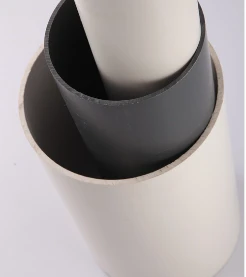Dec . 11, 2024 11:48 Back to list
pvc-m pipe
Understanding PVC-M Pipes A Comprehensive Guide
Polyvinyl Chloride Modified (PVC-M) pipes are gaining popularity in various industries due to their superior properties and versatility. These pipes, derived from conventional PVC, have undergone a modification process that enhances their mechanical properties, making them ideal for a range of applications, especially in water supply and drainage systems.
What is PVC-M?
PVC-M is a type of pipe made from a specially formulated version of PVC, which involves the addition of impact modifiers. This alteration grants PVC-M pipes improved toughness and flexibility compared to standard PVC pipes. The result is a material that can withstand higher pressures and has a greater resistance to environmental stressors.
Key Advantages of PVC-M Pipes
1. Enhanced Strength and Flexibility One of the most significant benefits of PVC-M pipes is their superior impact resistance. They can handle rough handling and installation conditions better than regular PVC, reducing the risk of cracking or breaking.
2. Lightweight and Easy to Install PVC-M pipes are lightweight, making transportation and installation simpler and more cost-effective. This ease of handling reduces labor costs associated with installation.
3. Corrosion Resistance Unlike metal pipes, which are susceptible to rust and corrosion, PVC-M pipes are resistant to chemical attack. This property ensures a longer lifespan and reduces maintenance requirements, an essential factor for municipal and industrial applications.
4. Hydraulic Efficiency The smooth inner surface of PVC-M pipes facilitates efficient fluid flow, reducing energy costs associated with pumping water. This feature is particularly beneficial in water distribution systems and irrigation.
5. Environmentally Friendly PVC-M pipes are recyclable, making them a more sustainable option compared to other materials. The reduced need for maintenance and replacement further minimizes environmental impact over the pipes' lifecycle.
Applications of PVC-M Pipes
pvc-m pipe

Due to their robust properties, PVC-M pipes are widely used in various sectors
- Municipal Water Supply They are commonly used in drinking water supply systems. Their ability to withstand high pressures and their resistance to biological growth make them ideal for this application.
- Agricultural Irrigation Farmers prefer PVC-M pipes for irrigation systems because they are durable and capable of withstanding the rigors of various weather conditions.
- Wastewater Management PVC-M pipes are used in sewer systems and for conveying industrial effluents. Their chemical resistance ensures that they can handle a variety of waste products without degrading.
- Mining The mining industry utilizes PVC-M pipes for transporting slurry and water in mineral processing. Their impact resistance is particularly beneficial in these challenging environments.
Installation and Maintenance
Installation of PVC-M pipes typically follows standard practices for PVC piping systems. They can be joined using solvent cement or mechanical fittings, which are easy to handle and quick to install. Proper trench preparation and pipe bedding are crucial for optimizing the performance and lifespan of the pipes.
Maintenance of PVC-M pipes is generally minimal due to their durable nature, but regular inspections are recommended to check for any signs of wear or damage. If managed correctly, these pipes can provide decades of service.
Conclusion
PVC-M pipes represent a significant advancement in piping technology, combining the benefits of traditional PVC with enhanced strength and flexibility. Their application across diverse fields, from municipal water systems to agricultural irrigation and industrial wastewater management, illustrates their versatility and reliability. As industries continue to focus on sustainability and efficiency, PVC-M pipes remain a favorable choice, promising longevity, cost-effectiveness, and environmental responsibility. As technology navigates towards more sustainable practices, this innovative piping solution is set to play a crucial role in future infrastructure development.
-
High-Quality PPR Pipes and Fittings Durable ERA PPR & PVC PPR Solutions
NewsJul.08,2025
-
Black HDPE Cutting Board - Durable, Non-Porous & Food Safe HDPE Plastic Cutting Board
NewsJul.08,2025
-
High-Quality CPVC Panel Durable HDPE & PVC Panels Supplier
NewsJul.08,2025
-
Double PE Welding Rod Supplier - High Strength, Durable & Versatile Welding Solutions
NewsJul.07,2025
-
High-Quality PVC-O Pipe Supplier Durable 75mm PVC Pipe & Connections Leading PVC Pipe Company
NewsJul.07,2025
-
HDPE Drainage Pipe Supplier – Durable & Corrosion-Resistant Solutions
NewsJul.06,2025

